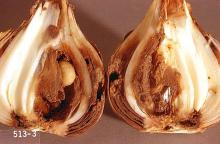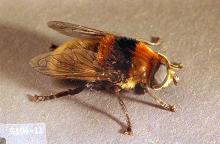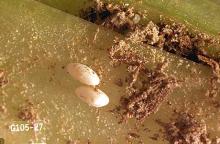Merodon equestris
Pest description and crop damage The adult narcissus bulb fly is about 0.5 inch long and closely resembles a small bumblebee. The larva is yellowish-white and 0.75 inch long. The maggots burrow into the bulbs near the basal plate and feed inside the bulbs, destroying bulb scale and flower parts. Infested bulbs may develop a few, grassy-looking leaves if the bulb is not too badly damaged. Severely damaged bulbs are soft, brown, and decayed. The narcissus bulb fly attacks amaryllis, daffodil, Galtonia, hyacinth, iris, lily, Leucojum, Narcissus, Scilla, tulip, and Vallota.
Biology and life history The female lays eggs near the bulbs during May or early June. The eggs hatch into grubs that move down into the soil and burrow into the base of the bulb to feed there, reducing the bulb's center to a rotten mass. In the process, the embryonic flowers that would have unfolded the following spring are destroyed. After feeding, larvae leave the bulb to pupate in the soil. In the spring, the grubs emerge as adult flies to mate and lay eggs.
Management-cultural control
Narcissus fly can be evaded by deep planting (10 inches). Plant in open areas exposed to wind. Bulb flies are usually less of a problem in such sites. Covering foliage of plants with a row cover after bloom prevents egg-laying. Plant only firm, healthy bulbs. Soft bulbs may be infested from the previous season. Destroy any soft bulbs to prevent emergence of adult bulb flies.
Management-chemical control
Apply when adults become active (early May-June). Direct stream to base of plants.
cyfluthrin (Decathlon)




